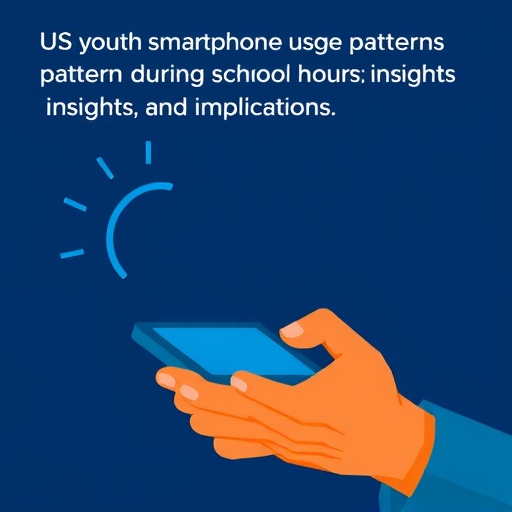
In an era where digital interaction dominates the social landscape of youth, recent research sheds critical light on the extent and implications of smartphone use among adolescents during school hours. A groundbreaking cross-sectional study published in JAMA Network Open rigorously examines the daily smartphone engagement of adolescents within educational settings, unveiling new findings that challenge previous assumptions about device usage during instructional time. This study not only quantifies the average smartphone screen time but also highlights the predominance of social media consumption, underpinning the evolving digital habits of young people in academic environments.
The investigation reveals that when adolescents have unrestricted access to their phones during school, they dedicate nearly an hour every school day to smartphone activity. What is particularly striking about this finding is the concentration of exposure to social media platforms, which constitute the majority of this usage period. This duration is significant, considering that it cuts into potential learning time and underscores a shift in adolescent focus within classrooms. Earlier research had suggested incidental or limited usage, but this study positions social media engagement as a central facet of smartphone use during school.
Developmental stages emerge as a crucial variable driving these usage patterns. The study details a clear differentiation between younger and older adolescents, with the latter exhibiting substantially greater engagement with both smartphones in general and social media specifically. This differential indicates that as adolescents mature, their integration with digital and social technologies intensifies, fostering more complex interactions and perhaps deeper social dependencies on these platforms. The developmental underpinnings of this trend warrant further exploration, especially concerning cognitive and emotional growth.
.adsslot_GkizBUjc1o{width:728px !important;height:90px !important;}
@media(max-width:1199px){ .adsslot_GkizBUjc1o{width:468px !important;height:60px !important;}
}
@media(max-width:767px){ .adsslot_GkizBUjc1o{width:320px !important;height:50px !important;}
}
ADVERTISEMENT
On a methodological level, the cross-sectional design of this study enabled researchers to capture a snapshot of behaviors across a broad demographic, reflecting real-world usage rather than controlled experimental settings. Such an approach provides valuable ecological validity, illuminating the genuine impact of smartphone access policies in schools. Through self-reports corroborated by objective data collection tools, the study offers robust evidence that fills a gap in understanding the extent of phone use and its social content during academic hours.
The implications of these findings extend far beyond mere statistics. The near-hourly engagement with smartphones during instructional time raises critical questions about the effects on attention, learning outcomes, and social development. While the study did not directly assess academic performance, the encroachment of screen time into classroom hours potentially disrupts traditional teaching and learning dynamics. Additionally, the social media focus suggests that adolescents may prioritize social validation and interaction over educational content when online.
Moreover, the social media platforms themselves, with their design engineered to capture and retain user attention, compound this issue. Algorithms optimized for engagement can foster prolonged usage, particularly among impressionable younger users. This interplay between device accessibility, platform design, and adolescent psychology creates a nexus that educational policymakers must reckon with when crafting phone usage guidelines in schools.
Of equal importance is the recognition of heterogeneity within the adolescent population. Variability in usage patterns linked to age, and possibly other factors such as gender, socioeconomic status, and school environment, hints at the complex social fabric influencing digital behaviors. Tailored interventions that consider these nuances rather than one-size-fits-all bans or allowances might prove more effective in managing phone use within schools.
The study also raises the question of the developmental trajectory of digital habits, suggesting potential longitudinal consequences. Prolonged reliance on smartphones and social media for communication during formative years may shape social skills, attention spans, and mental health in lasting ways. Further longitudinal research could illuminate how early patterns of smartphone use translate into adult behaviors and outcomes.
While the primary focus was on social media, the study implicitly touches upon other smartphone activities, such as gaming, streaming, or non-social communication, though these occupy a lesser share of usage time. Distinguishing among these activities could help educators and parents understand what motivates phone use in classrooms and identify healthier engagement models.
Technological advancements may simultaneously offer solutions. For example, apps or operating system features that monitor and limit screen time could be integrated into school policies, leveraging digital tools to promote self-regulation among students. Additionally, educators might incorporate smartphone usage into pedagogical strategies, transforming potential distractions into educational assets.
Crucially, the authors caution that smartphone use during instructional hours is far from trivial. Rather than dismissing it as incidental, the evidence compels a reconsideration of school phone policies, adolescent digital culture, and the role of technology in education. The findings advocate for balanced approaches that acknowledge adolescents’ digital realities while safeguarding learning environments.
Contact with the corresponding author, Dr. Scott H. Kollins, provides further avenues for discourse and collaboration. His insights and expertise shed light on the intricate relationship between adolescent development, technology use, and educational practices, fostering informed policymaking and research.
This important study, available through JAMA Network Open, invites educators, researchers, and policymakers to confront the complex challenges posed by pervasive smartphone and social media use among young learners. Understanding and adapting to these realities will be essential to optimizing educational outcomes and supporting healthy adolescent development in an increasingly connected world.
Subject of Research: Adolescent smartphone and social media usage during school instructional hours.
Article Title: (doi: 10.1001/jamanetworkopen.2025.23991)
Web References: https://media.jamanetwork.com/
Keywords: Smartphones, Young people, Adolescents, United States population, Social media, Developmental stages
Tags: adolescents and social mediaclassroom smartphone distractionscross-sectional study on youth technologydigital habits of teenagerseducational settings and technology useimpact of social media on learningimplications of smartphone use in educationscreen time statistics for studentssmartphone access in schoolssmartphone engagement during schoolsmartphone implications for adolescent developmentUS youth smartphone usage





